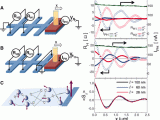Grain boundary segregation occurs during thermal treatment and results in formation of thin layers of different composition compared to the base material which is spread continuously throughout a device. This often results in loss of cohesion in these regions and in embrittlement of the device which is extremely dangerous in applications.
You are here
Significant results of scientific activity in year 2010
Magnetoelectric multiferroics are materials, which exhibit simultaneously magnetic and ferroelectric order. Unfortunately, there are only few multiferroics in nature and they have usually low critical temperatures and their magnetoelectric coupling is small. In this paper we first time experimentally demonstrated that new "artificial" multiferroics can be prepared using the strain in the thin films. We proved that originally antiferromagnetic and paraelectric EuTiO3 changes in strained films to strong ferromagnet and ferroelectrics due to strong spin-lattice coupling.
The first paper published by the ATLAS Collaboration using an early LHC data. Properties of ordinary proton-proton interactions were measured at center of mass energy of √s = 900 GeV. The data are important for tuning models of soft, low momentum transfer physics. These events constitute a background to the short-distance scale physics which is the main focus of ATLAS and CMS. Understanding this background is important for full exploration of discovery potential of the LHC.
60 years after the discovery of a transistor its operation is still based on the same physical principle of electrical manipulation and detection of electron’s charge in a semiconductor. Since we are quickly approaching the ultimate down-scaling limit it is now an eminent task to establish new physical principles of transistor operation. One extensively studied possibility is utilizing the second basic attribute of electron which is its spin. Theoretical proposal of electrical manipulation and detection of electron’s spin in semiconductors is 20 years old.
This review summarizes recent first-principles investigations of the electronic structure and magnetism of dilute magnetic semiconductors (DMSs) use in spintronics. Details of the electronic structure of transition-metal-doped III-V and II-VI semiconductors are described, especially how the electronic structure couples to the magnetic properties of an impurity. In addition, the underlying mechanism of the ferromagnetism in DMSs is investigated from the electronic structure point of view in order to establish a unified picture that explains the chemical trend of the magnetism in DMSs.
We study theoretically the electronic states in a 5d transition metal oxide Na2IrO3, in which both the spin-orbit interaction and the electron correlation play crucial roles. A tight-binding model analysis together with the first-principles band structure calculation predicts that this material is a layered quantum spin Hall system. Because of the electron correlation, an antiferromagnetic order first develops at the edge, and later inside the bulk at low temperatures.
This extensive article was written under the guidance of FZU group and it describes the world largest Fluorescence detector system. The group initiated the very idea of writing the paper, contributed with a chapter on the optical setup, organization of various international groups, text editing, correspondence with referees, chapter on detector operation, etc. The article describes the components of the fluorescence detector including its optical system, the design of the camera, the electronics, and the systems for relative and absolute calibrations.
Silicon nanocrystals are an extensively studied light-emitting material due to their inherent biocompatibility and compatibility with silicon-based technology. Although they might seem to fall behind their rival, namely, direct band gap based semiconductor nanocrystals, when it comes to the emission of light, room for improvement still lies in the exploitation of various surface passivations.
We have investigated by means of neutron diffraction and magnetic measurements the particle size effects on the structure and low-temperature spin arrangement in so-called half doped manganites. The study shows that the Mn3+/Mn4+charge ordering and CE-type antiferromagnetic structure characteristic for bulk are completely suppressed when particle size is decreased down to 20 nm, and a ferromagnetic state is stabilized instead.
Modulated phases occur in numerous functional materials like giant ferroelectrics and magnetic shape-memory alloys. For the first time we showed that Ni-Mn-Ga modulated martensite exhibiting the giant magnetically induced strain (magnetic shape memory effect) can be considered as an adaptive phase which profoundly changes the perception of modulated phases in this materials and it is important for understanding of the effect.











